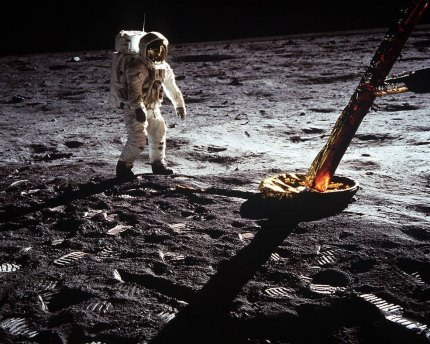
Anyone who was old enough to watch television (and understand what they were watching) remembers July 20, 1969, when Neil Armstrong and Buzz Aldrin landed the lunar module Eagle. Later, when Armstrong stepped out, he said, “That’s one small step for a man, one giant leap for mankind.”
The Apollo 11 mission is being remembered with a festival in Washington, D.C. (see details below), television specials and articles on multiple websites. Beyond the achievement for NASA, its technicians, scientists and astronauts, the mission gave rise to other discoveries and insights. Here are some examples:
Engineering: While everyone remembers Armstrong and Aldrin, a third astronaut, Michael Collins, remained in orbit in the command module Columbia. His part in the journey was important. Getting the two astronauts back off the moon was considered the most perilous part of the mission. Read about the landing from an engineering point of view on the website of the American Society of Mechanical Engineers.
The article is: "Analysis of lunar samples: Implications for planet formation and evolution," by Richard W. Carlson, Department of Terrestrial Magnetism, Carnegie Institution for Science.
Math: NASA points out that the math developed in navigating the moon later was used on Earth to increase air flight efficiency. See the article on the NASA website.
Schedule for the Apollo 50 Festival:
For those in Washington, D.C., for the occasion, the National Air and Space Museum and NASA are hosting Apollo 50 Festival on the National Mall. The festival started July 18 and is scheduled for July 19 from 9 a.m. to 5 p.m., and July 20 from 9 a.m. to 8 p.m.There will be a stage and 20 tented displays with hands-on exhibits from NASA, Boeing, Raytheon, The LEGO Group, and PBS' Ready Jet Go!, according to the Smithsonian.
Earlier this week, a 363-foot image of the Saturn V rocket was projected onto the Washington Monument. Over the weekend, a 17-minute program, "Apollo 50: Go for the Moon," will be shown on the monument along with screens on the mall. The projections will begin at 9:30 p.m., 10:30 p.m. and 11:30 p.m. Friday and Saturday.
Temperatures are expected to be in the upper 90s. So, inside:
- The National Archives, 701 Constitution Ave. NW, Washington, D.C., will show the movie First Man, a biopic about Armstrong,on July 20 at 2 p.m.
- The Smithsonian National Air and Space Museum, Independence Avenue at Sixth Street SW, Washington, D.C., is showing a "Discover the Moon" day July 19, from 10 a.m. until 3 p.m. at the museum in Washington. Displays include Armstrong's spacesuit. The museum will also host The Eagle Has Landed Late-Night Celebration, July 20, from 8 p.m. until 2 a.m. The museum's website promises a special countdown at 10:56 p.m. marking the exact time Armstrong first set foot on the moon.
- The National Gallery of Art, between Third and Ninth Streets along Constitution Avenue NW, Washington, D.C. has an ongoing exhibition, By the Light of the Silvery Moon: A Century of Lunar Photographs. The gallery is open from 10 a.m. until 5 p.m. Saturday and from 11 a.m. until 6 p.m. on Sunday. The gallery will also include showings of films at the East Building Auditorium, including The Right Stuff, July 20 at 11 a.m., and Cycles, Tides, and Rhythms: The Moon on Film at 3 p.m. The science fiction film,The Man Who Fell to Earth, will be shown Sunday, July 21, at 4:30 p.m.
Related:
Four history-shaping anniversaries
First man: Officials prepared for moon disaster
Like us on Facebook and tell us what you think.